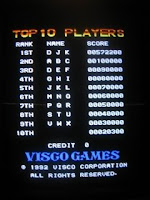 |
| Getting back into some Raizing goodness takes a bit of getting used to, as noted in my Ibara post last month. Confronting rank is like running into a brick wall at 100 miles an hour. You think you can bash straight through it, only to have your ass handed back to you just as quick. This is what makes Raizing games so much fun to play, as you really need to plan your objectives, be that 1CC with low rank, or scoring with high rank, or in some cases - a very fine line in between. Yagawa is a master at making this all too apparent with his games. |
So this weekend I focused some time on
Battle Bakraid, the arcade only successor to
Battle Garegga, with some interesting differences in rank based scoring. I won't detail the differences in this post, but point out that in Bakraid you can actually ignore rank if you are not gunning for high scores, and focus solely on the 1CC in Normal mode. Combining this with an auto-bombing Training mode, makes the game accessible to beginners.
So where is the rank? Well if you want to play for score, you better get ready for some very unorthodox style of play. Imagine a game were bombing and committing suicide with your ship every 10-15 seconds is required to score high! Quite the opposite of Cave (and any other) style shmup, yet Yagawa's genius shines through. Even in Battle Garegga, where players were first exposed to suicide techniques to lower/tame rank, Bakraid takes this to the extreme with a 64x multiplier leading to amazing scores, amazing amounts of extends (extra ships), and an amazing amount of rank. Some people might think this "breaks" the game, and that such an unorthadox style of play must not have been intentional. The same thing was said years later of Yagawa's
Pink Sweets. All I can say is that Yagawa's games truely innovate outside the norm of repetitive Cave style shooters, causing the player to plan/think rather then simply react with twitch reflexes.
And with that, I give you my latest Normal and Advanced course scores. Basically I temped fate by scoring large in the first two stages, and then play it safe from there on out. I've been able to 1CC Normal mode before but with only a 5M to 6M score. With this in-between strategy, I've been able to double my score, and still complete the 1CC. I tried the same technique in Advanced mode, only to learn that once you get 4 ships in stock, the rank gets so pissed, that there is now way in hell you will get past stage 6. I literally had a chain of missiles heading for me that I could not shoot down fast enough, even with forward facing options pointed straight at them.
My scores below are ranked #3 on my PCB, since I didn't bother resetting Rastan78's scores the last time he was over (a real master at this game). The last screenshot is the special Boss only mode, where I made it to the second form of Gollum.



DJK - 12,390,280 - Saber Tiger [C] - ALL - Normal (SE)
DJK - 12,416,350 - Saber Tiger [C] - Stage 6 - Advanced (SE)
DJK - 10,832,250 - Flame Viper [C] - Gollum - Boss



























































